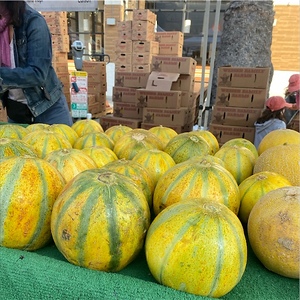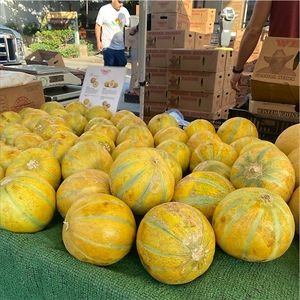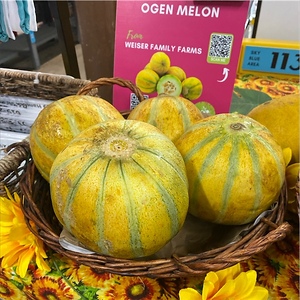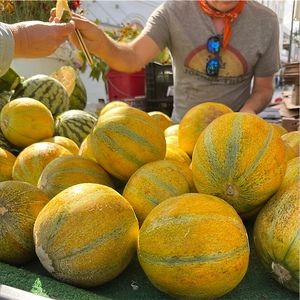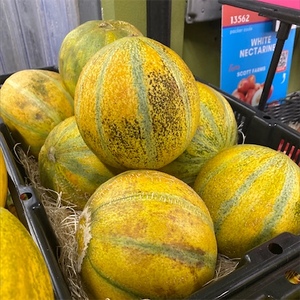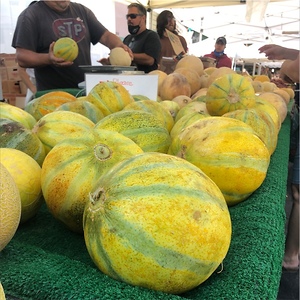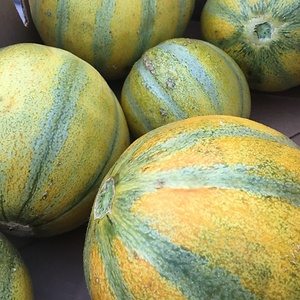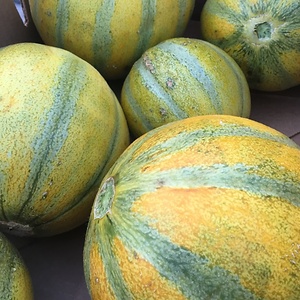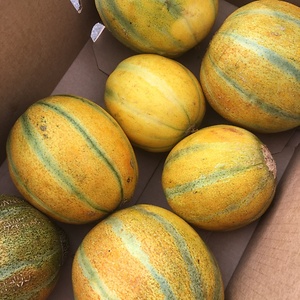

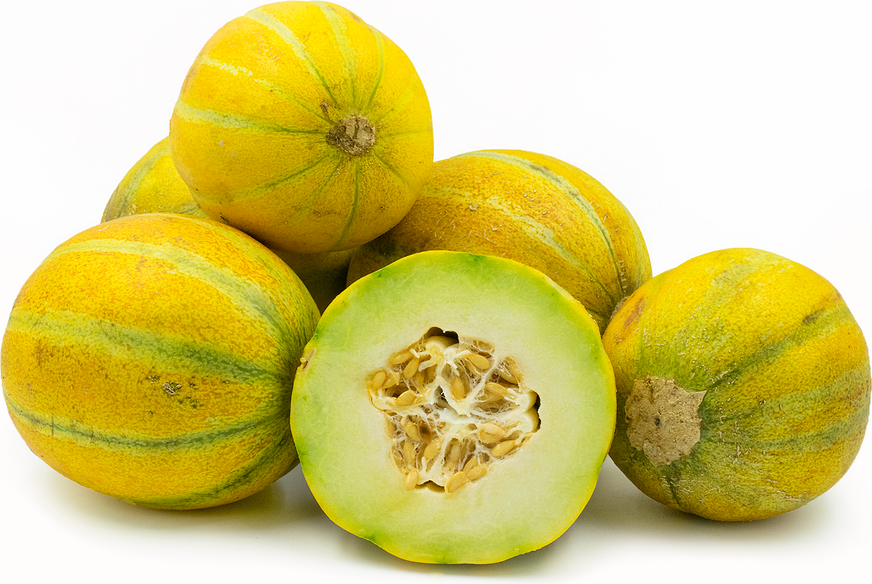
Ogen Melons
Estimated Inventory, ea : 0
This item was last sold on : 08/01/24
Description/Taste
Ogen melons are a small to medium varietal, averaging 12 to 15 centimeters in diameter and 1 to 2 kilograms in weight, and have a round to oval appearance with curved, blunt ends. The melon's rind is semi-thin, textured, netted, and firm, showcasing distinct striping extending from the stem to the blossom end. When ripe, the rind transitions from dark green to golden yellow, and the shallow sutured grooves generally maintain a green hue, sometimes becoming variegated with yellow shades. Underneath the surface, the pale green flesh is thick, dense, and aqueous with a tender, succulent consistency. The flesh also encases a central cavity filled with oval, cream-colored seeds suspended in a gelatinous liquid and stringy, white fibers. Ogen melons release a sweet, tropical, and floral aroma when ripe, and the blossom end will yield slightly to pressure. The flesh has high sugar content, creating a honey-sweet flavor followed by a pleasant, lingering tang.
Seasons/Availability
Ogen melons are available in the summer.
Current Facts
Ogen melons, botanically classified as Cucumis melo, are heirloom muskmelons belonging to the Cucurbitaceae family. The open-pollinated variety matures in approximately 80 to 85 days, and each plant generally produces 3 to 4 melons. Ogen melons arose from Israel in the mid-20th century and were highly valued for their sweet flavor, juicy flesh, and fragrant aroma, quickly becoming a favored variety worldwide. The melons are also known as Ha'Ogen, Israel Cantaloupe, and Desert melons, and in some Israeli markets, there may be several varieties of melons generally labeled under the name Ogen. In the modern day, Ogen melons are a specialty melon cultivated worldwide as a fresh eating variety.
Nutritional Value
Ogen melons are a source of vitamin A to maintain healthy organ functioning, fiber to regulate the digestive tract, and vitamin C to strengthen the immune system while reducing inflammation. The melons also provide potassium to balance fluid levels within the body, iron to develop the protein hemoglobin for oxygen transport through the bloodstream, calcium to build strong bones and teeth, and other nutrients, including copper, zinc, vitamin K, and folate. In addition to vitamins and minerals, Ogen melons contain pectin, a soluble fiber that helps cleanse the digestive tract.
Applications
Ogen melons have a sweet, honeyed flavor suited for fresh preparations. The melons have a juicy, succulent flesh typically savored straight out of hand. Ogen melons can also be sliced and tossed into salads, mixed into fruit bowls, displayed on charcuterie boards, or wrapped in cured meats as an appetizer. In addition to fresh preparations, Ogen melons can be blended and frozen into popsicles, sorbets, ice cream, and various frozen cocktails. The melons can also be thinly shaved and stacked over slices of cucumber with dollops of dip, sliced and topped over pesto pizza, or they can be used to flavor bread, cakes, and pastries. Ogen melons pair well with cheeses such as goat, ricotta, and feta, nuts including hazelnuts, almonds, and pistachios, fruits such as figs, peaches, nectarines, grapes, and berries, arugula, chiles, vanilla, and herbs including cilantro, basil, and mint. Whole, unopened Ogen melons will keep for 3 to 5 days at room temperature to ripen. Once mature, the melons should be stored in the refrigerator. Sliced melons will keep 1 to 3 days in a sealed container in the fridge.
Ethnic/Cultural Info
The name Ha'Ogen translates from Hebrew to mean "the anchor." This steadfast moniker was given to the melon variety in honor of the Ha'Ogen kibbutz in Israel. The kibbutz was established in 1947 and is an agriculturally based community in the Huwarat Valley. The Ha'Ogen kibbutz was known for having a diverse cultural background in the 20th century, and many residents traveled from Hungary, Italy, Czechoslovakia, Austria, and other countries to settle in the kibbutz. This blend of traditions, expertise, and knowledge fostered a prosperous agricultural community, leading to the cultivation of the Ogen melon. When the variety was initially grown, it was heavily protected and kept a secret within the kibbutz. News about the melon slowly leaked from the kibbutz, causing murmurs among other communities, but the melon was so well hidden that it came to be labeled as a local urban legend for a short period. The variety was eventually released and publicized, and the kibbutz began cultivating the melons and seeds for commercial sale.
Geography/History
Ogen melons were popularized in Israel and were first recorded in the 1950s. There is some dispute among experts as to the origins of the melon, with some tracing the melons to Hungary, while others say Israel. Despite the contested origins, Ogen melons were named and commercialized in the Ha'Ogen kibbutz in Israel and were spread throughout the region. The kibbutz also has a record mentioning that the first shipment of Ogen melons was exported abroad in 1956. Over time, Ogen melons were introduced via seed worldwide and are a specialty cultivar grown in melon-producing regions in Europe, Asia, North America, South America, and Australia. The variety also received the Royal Horticultural Society's Award of Garden Merit, an honor given to cultivars that exhibit exemplary growth characteristics, flavor, and quality. Today Ogen melons can be found through select distributors, farmers markets, and home gardens worldwide.
Recipe Ideas
Recipes that include Ogen Melons. One
| Two Peas and Their Pod |
|
Melon Salad with Mint, Lime, and Sea Salt |
| Amelia Saltsman / Food |
|
Melon and Cucumber Salad with Mint |



